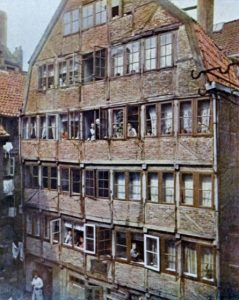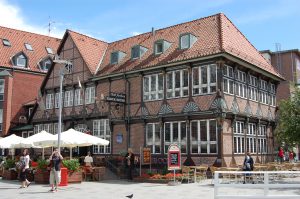
Speckgang 24, Hamburg,
Brahms’s birthplace
It’s not exactly where you’d wish to be born and grow up, is it?
A large, shabby tenement building in a run-down area of Hamburg, close to the city walls. This is the crowded Gängeviertel, or Laneway Quarter of the North German port city, where tall, gabled wood-framed buildings of brick, clay and straw are packed together in narrow laneways.
One of Brahms’s earliest biographers, his piano pupil Florence May, visited the family’s former apartment in 1905, a few years after her mentor’s death. Feeling “a shiver of bewilderment and dismay” as she surveyed the cramped quarters, May apologises to her readers for having to speak of “the commonplace reality of bare and repulsive poverty.”
Poor Johannes! But there’s worse to come.
This image of Speckgang 24 (later renumbered to Speckstrasse 60) has been reproduced on many web postings and in books about the composer. Pages of myths have portrayed Johannes Brahms as the romantic hero, rising from the slums of Hamburg to become the most celebrated composer in Vienna, the city of the great classical masters.

1906 plaque marking Brahms’s birthplace
It’s an easy hook to swallow.
A recent visit to Hamburg gave me an opportunity to assess how much of the bait I might have swallowed over the years and see a few of the remaining sights known to the composer in a city that he called home for more than half of his life.
My starting point was the Brahms Museum at Peterstrasse 39, a few minutes walk from the St. Pauli U-Bahn station. The museum is housed in a detailed reconstruction of the old Hamburg townhouses known to Brahms. Most did not survive the Great Fire of 1842 and the devastating 1943 weeklong bombing and resulting firestorm that all but wiped out the German port city.
The museum’s holdings are modest and mostly drawn from the Hoffman Collection, the largest privately held Brahms archive.
Among what survives from Brahms’s early years are a baptism spoon, silver tumbler and confirmation cup.

Brahms’s baptismal font from 1833 also survives in today’s St. Michael’s Church (Michaeliskirche)

The rebuilt Michaeliskirche, Hamburg’s largest church, was again badly damaged in 1943 but, once more restored, continues to dominate today’s Hamburg skyline.
C.P.E. Bach is buried in its crypt. He was city music director for Hamburg’s five churches.
Georg Phillip Telemann was his predecessor in the role.

A fire in 1906 destroyed the Michaeliskirche as Brahms knew the historic building

Peterstrasse, Hamburg – Brahms Museum in foreground

One corner of Hamburg’s new Composer’s Quarter. The ’Hamburg’ Bach and Hasse museums, together with an excellent café (try the Esterházy wine that Haydn would have known)
The Brahms museum opened in 1971. A Telemann museum opened next door in 2011. Now, with the restored burger’s and merchant’s houses on Peterstrasse designated as Hamburg’s ‘Komponisten-Quartier’, museums for C.P.E. Bach and his contemporary Johann Adolf Hasse are also open to the public.
Making up for lost time, further museums for Fanny and Felix Mendelssohn (both born in Hamburg) and for Gustav Mahler (opera are in the works.
Who’s next? Russian composer Sofia Gubaidulina has lived here for two decades. Alfred Schnittke spend his last decade in the city and Hungarian composer György Ligeti was taught in Hamburg during the 1970s and 80s. Oh yes, which member of a quartet of musicians said “I might have been born in Liverpool, but I grew up in Hamburg?”
Two enduring memories from the Brahms museum are the magnificent marble bust which greets the visitor on arriving and the square piano upstairs on which Brahms, in his late 20s, gave piano lessons. Taking a copy of the least technically challenging Brahms Intermezzo that was in my repertoire 50 (!) years ago from the Complete Brahms Edition in the bookcase behind the piano, your reporter played the piano that Brahms himself had played in the city of his birth. No-one save the marble bust and an understanding curator witnessed this random act of violence.

Marble bust of Brahms made in 1903 by the Austrian sculptor Ilse Conrat. She also created the gravestone for Brahms in the musician’s quarter of the Central Cemetery in Vienna

Square piano by Hamburg makers Baumgardten & Heins, manufactured in 1859. Brahms gave piano lessons in Hamburg using this instrument in 1861/2

Johann Jacob Brahms (1806-72)
Johann Jacob Brahms, the composer’s father, was a musician by profession. His five years of music study taught him the way around violin, viola, cello, flute, flügelhorn and, above all, double-bass.
He started playing in the cafes and Lokals (places of entertainment) in the St Pauli suburb of Hamburg, odd-jobbing as a street musician wherever there was money to be made. 30 years playing flügelhorn with the civil militia brought a modest pension for life.
In 1831 he became a founding member of the Hamburger Musikverein. By the 1840s, he was known as one of the best double-bass players in Hamburg, performing at the Stadttheater and in the Philharmonic concerts.
He continued to play music in the taverns between gigs in the concert hall throughout his working life. Brahms senior was industrious, down-to-earth, respected and convivial in company. He worked his way up the social ladder – when such things mattered – to a social position somewhere on the line between lower and middle class, from rural petit bourgeois to respected Bürger.
Johann Jacob Brahms was, in the words of musicologist and collector Kurt Hoffman (to whom I am indebted for many of the details of the Brahms family life), “a role model, always admired by his son.”
I mean this sort of thing, taken from one of the books on my shelves, Brahms,a Critical Study by Burnett James (Dent, 1972):
“In the Hamburg Lokale, Brahms made direct contact with the low of sex*, and the impact made an ineradicable impression. The boy Johannes not only played the piano but probably sang also in a piping treble . . . in the taverns and alleyways of the dock areas. The whores frequented tavern and alley alike, anywhere the sailors moved or gathered; and few of these ladies of the oldest profession were above using the handsome, sensitive, fair-haired boy to help excite the passions of potential customers. Thus Johannes found himself in all too close proximity to semi-naked (even naked at times) female flesh of no particular sweetness or cleanliness. The whole business revolted him; and he never forgot.”
[* a misprint – publisher’s edit, perhaps?]
Steamy stuff! But fiction according to Hoffman who has thoroughly researched the social and economic minutiae of the Brahms family and 19th century Hamburg.
Brahms senior had an annual income of between 800 and 1,000 marks in 1840, at a time that the annual rental on a modest family dwelling amounted to 60 Hamburg marks. That income peaked at 1,800 marks in 1864, by which time Brahms’s parents and their three children had moved apartments eight times, each time to a larger and more costly location in Hamburg.

Brahms’s birthplace was destroyed in 1943. This monument now commemorates the site
Brahms (‘Jehann’ or ‘Hannes’ as he was called by his family) was given what he later referred to as the ‘best grounding’ in piano by his first teacher, Otto Cossel, who taught the gifted young musician to express through his fingers what he felt in his heart. This advice stayed with Brahms.
When an impresario offered the ten year-old Wunderkind a concert tour to the United States, the offer was reluctantly declined. In return, Eduard Marxsen, Hamburg’s principal music teacher, took over his private piano, composition and theory teaching, gratis.
By 14, Brahms arrived at day school by 7:00 a.m., not so much to study, but more to give his school teacher free piano lessons!
Throughout these very early years, Brahms recalled in later life: “I composed, but only in secret and very early in the morning. All day, [weekends and vacations presumably] I arranged marches for wind music and at night I sat at the keyboard in taverns.”
So here we have the beginnings of the story of playing in taverns that Brahms planted in his later years. Biographers immediately ran with it and then began to elaborate.
“Brahms never played in Tanzbordellen,” Hoffman says, quoting a Hamburg statute from 1834 banning entry to bordellos by persons under 20. Even dance music was forbiddden under the city’s Bordellos and Prostitution regulations.
So Brahms, who at an early age, had inherited his father’s work ethic, was exaggerating his rise from poverty to independence and prosperity as a freelance composer – putting a romantic glow of the memories of youth. Yes, he played in Kneipe or inns, where food was served along with the wine. But not in the brothels and never, according to Hoffman’s research, before the age of 13.

Gasthof ‘Stadt Hamburg, ‘Bergedorf, as it was . . .

. . . and today. Brahms likely played in this historic Hamburg Gasthof (1669). It is located opposite St Peter’s Church
A friend, pianist Christian Miller, heard the young Brahms playing for a dance at a summer inn in Bergedorf for a fee of two thalers for the afternoon. This was good money – half a week’s wage for a printer at the time. Miller returned the following Sunday afternoon with Brahms – just for the fun of it – and the friends played piano duets for the surprised Gasthof guests.

Johanna Henrica Christiane Brahms (1789-1865). Photo taken three years before her death
Brahms’s mother encouraged a sense of thrift in her son. When he was 21 she reminded him of the bank account she had opened for him years earlier. “When you had work from [the Hamburg music publisher] Cranz for a time, which brought you in a considerable sum, do you remember how I took care that the money went into the bank?” she wrote.
Johann Jacob Brahms and Johanna Henrica Christiane Nissen were married June 9, 1830. Brahms was the second of three children born to a mother who was 17 years older than her husband. At the time of his birth, May 7, 1833, the family was living in the back courtyard on the first floor of the apartment building pictured at the top of this post. The city was still built round the relatively small, formerly Hanseatic port, with its sailing ships and as yet undeveloped portlands.
This was a far cry from today’s massive port, the largest in Germany, with 43 kilometres of quay.
Crucially, it was also a far cry from the port it had become by the end of the 19th century when Brahms’s earliest biographers were making the pilgrimage to the city where the celebrated, now deceased composer had spent roughly half of his life.
When Brahms was born, the Gängeviertel quarter was then leafy, with tended gardens and half-timbered apartment buildings grouped around the laneways between. It was a respectable neighbourhood where the middle-class lived. The family moved to even better quarters when Brahms was just six months old.
Later in the century, with the expansion of the port into the Neustadt and with Hamburg now the major Central European port for transatlantic traffic, the area fell into disrepair and disrepute. This was the Gängeviertel on which biographers built their picture of the composer’s childhood, fueled by the aging composer’s predilection for a romanticised tale of childhood poverty.

Brahms in 1853, at 20. This is the earliest known photograph of the composer
Brahms only made a lasting committment to Vienna when he was 38. “I am rather old-fashioned in most respects . . . and cling to my native city as to a mother,” he wrote to pianist Clara Schumann in 1862. He lived at home until he was almost 30, then lived in seven or more residences (including Vienna) while touring as a pianist and conductor or seeking a quiet retreat for composition. But it was only on December 27, 1871 that he rented rooms at Haus Wien, Karlgasse 4, Vienna, where he would remain for the final 25 years of his life.
Brahms’s ties to Hamburg ran deeper than family ties alone. Throughout his life he continued to contribute to his family’s income, supporting both parents when they separated in 1864, then his father after his retirement in 1869, and his sister Elise even after she married.
He kept a room and all of his books in one or other of the family homes until 1869.
Brahms was seeking a professional position throughout his years in Hamburg and well into his time in Vienna. Top of his list was the conductorship of the Philharmonic Orchestra, his father’s orchestra – and Brahms knew that, with such an appointment, no father would have been more proud of his son than would Johann Jacob. It was not to be. Twice passed over, Brahms held a grudge against the organisation until the end of his life. When the members of the committee of the Hamburg Philharmonic Society finally offered the position in 1894, the 61 year-old Brahms replied from Vienna with a letter conveying emotions ranging from regret to disdain:
“It was long before I got used to the idea of going along other paths. If things had gone according to my wishes I would perhaps celebrate an anniversary with you today; but in that case you would still have to look around for a younger capable talent. May you find him now, and may he serve you as faithfully as would have . . . your respectful and obedient servant, J. Brahms.”
Brahms’s personality was complex and not easy to live with. There is, of course, another side to his deep anger over not having been sooner offered the conductorship in his native city. Several of his friends and supporters felt that his lack of both practical and people skills disqualified him for the position. Even Clara Schumann, arguably the person he felt closest to in the 1860s, recommended someone else over Brahms for the position, though Brahms never knew this.
As we sailed out of Hamburg, I wondered what the city’s most famous composer would have made of the new concert hall, the Elbphilharmonie, about to open two months from the time of this posting, on January 11, 2017.

The Elbphilharmonie in the HafenCity quarter

Like a proud galleon sailing down the river Elbe

Off to the tavern . . . but in Vienna, not Hamburg. Zum roten Igel (The Red Hedgehog) was Brahms’s favourite dining establishment
The crystal structure sits atop an old brick warehouse like a proud galleon sailing down the Elbe. And proud she should be, having docked with a $1.22 billion (€860 million) pricetag, more than 10 times the original estimate.
There will be a party, of course, with a three-week festival showcasing the Elbphilharmonie’s three concert halls, large music education area, hotel and panoramic viewing platform with views of the city. The Hamburg Philharmonic will be part of the festival, but not as resident orchestra of the main 2,100 seat, vineyard-shaped Grosser Saal – that honour goes to the NDR (North German Radio) Elbphilharmonie Orchestra.
Neither orchestra is offering an homage to Brahms during the opening festivities. The only orchestral Brahms to be played in the festival will be orchestral transcriptions of four of his Chorale Preludes and the Four Serious Songs . . . the two final works from his pen.
And the orchestra? . . .
. . . it’s not from Hamburg; it’s the visiting Vienna Philharmonic, from Brahms’s adopted city.
Brahms’s Piano Trio in B, Op. 8 (1853-4, rev. 1889) will be performed by the Gryphon Trio, December 15
© copyright 2016 Keith Horner – khnotes@sympatico.ca